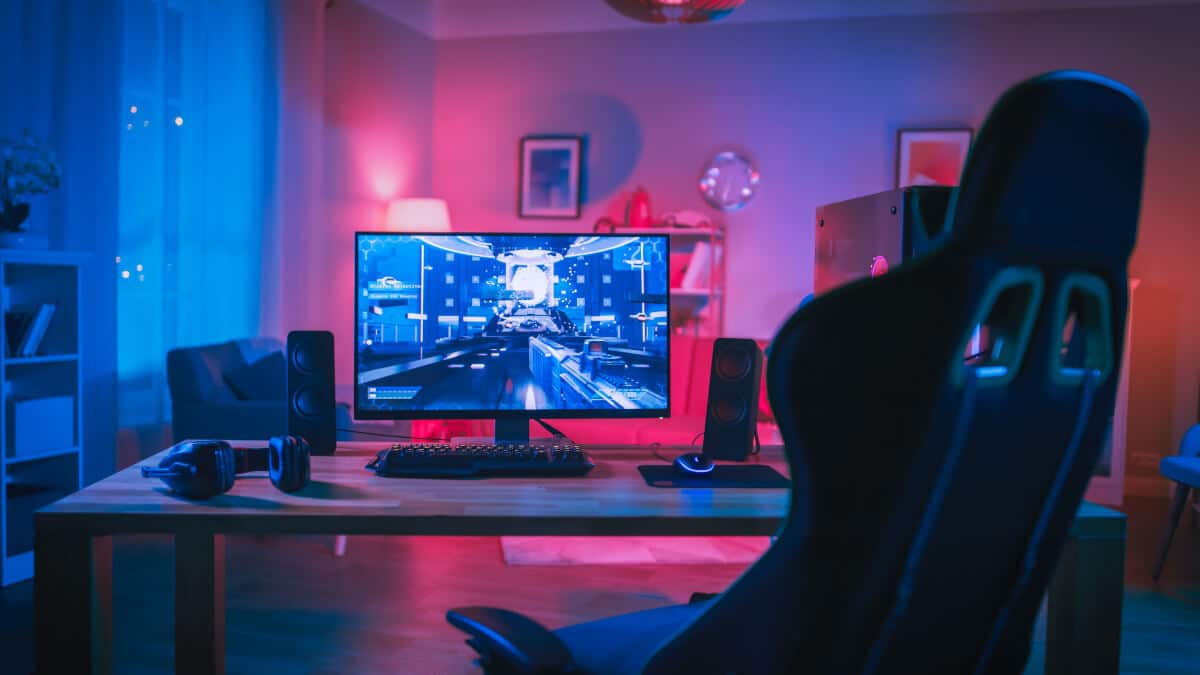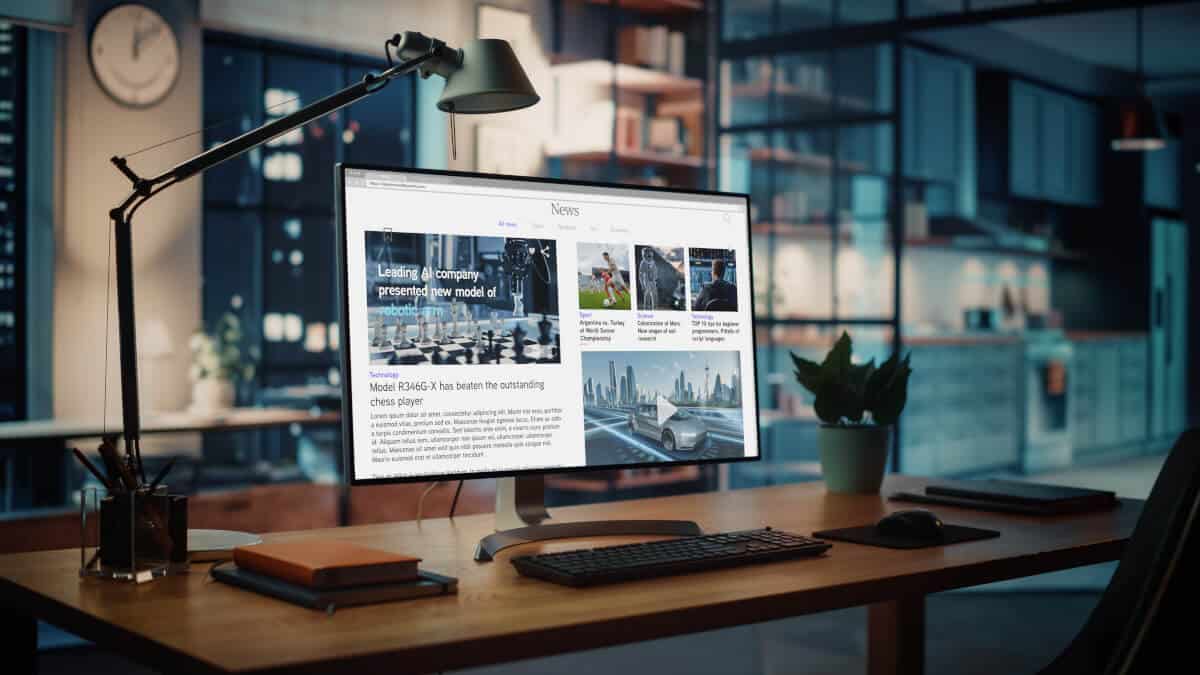the essentials in brief
A monitor is an electronic display device that is typically connected to a computer or laptop. More about this here..
The price of a monitor varies depending on size, functionality and quality. Standard monitors can be relatively cheap. More here..
Whether a monitor is better than a TV depends on individual needs and requirements. Read more here...
A monitor can make things easier for you. But why is such a screen an advantage? What is the difference to a normal screen? What functions does such a device have? What do you have to consider when you want to buy a monitor? Everything you need to know is in the following article.
Contents
The monitor - your window to the digital world

A PC monitor is a display device that displays images and videos from a computer or other electronic device. In contrast to a conventional screen, a monitor is usually larger and higher Resolution and is designed for longer viewing times.
Before you buy a monitor, you should think about what you want to use it for. If you only read email and surf the web occasionally, a standard monitor will do. However, if you frequently watch movies, play games, or perform graphics-intensive tasks, you should opt for a monitor with a higher resolution and faster refresh rate.
There are also different types of computer screens, such as LCD, leds, OLED and CRT. Each has its pros and cons and is better suited to certain tasks than others. It is important that you consider which type is best suited to your needs.
A monitor is an important part of your computer or home entertainment setup. By choosing a monitor that suits your needs, you can ensure you're having the best visual experience possible.
Monitor costs vary depending on the type, size and range of functions. Standard monitors can be relatively inexpensive, while high-end monitors with advanced features and technology are more expensive. It's important to keep your budget in mind and choose a monitor that fits your needs and budget.
Did you know already?
An interesting fact is that the first computer monitor, the CRT (cathode ray tube) monitor, was invented in 1934 and was the most commonly used monitor type until the late 2000s.
The power of the monitor - why a good monitor makes all the difference
A monitor is a crucial element of your digital experience, whether it's at work, gaming, or watching movies and videos. Here are some reasons why a monitor is so important:
- Size and resolution: A larger, higher-resolution monitor allows you to view more information at once and see more detail in images and videos.
- color fidelity: A monitor with high color fidelity reproduces colors more realistically and allows you to enjoy images and videos in their natural beauty.
- eye comfort: A good monitor reduces eye strain and fatigue by providing the right brightness, contrast and Color temperature offers.
- Gaming: A monitor with a fast refresh rate and low input lag is crucial for a smooth and responsive gaming experience.
- Productivity: A large monitor with high resolution allows you to use multiple applications at the same time and work faster, which can increase your productivity.
A good monitor is therefore not only a luxury, but also an important investment in your digital life. Choose the right monitor for your needs and enjoy a better visual experience.
More than just a screen - the diverse functions of a monitor
Modern monitors offer a variety of features that can enhance the visual experience and make the computer easier to use. Here are some of the key features and their benefits:
- Screen size and resolution: A larger screen size with higher resolution allows you to view more information at once and see details in images and videos better.
- Brightness and Contrast: Good brightness and contrast adjustment is important for eye comfort and vision. High brightness and contrast allow text and images to be seen more clearly and distinctly.
- color fidelity: Monitor color fidelity is important for displaying realistic colors and ensuring images and videos look the way they are intended.
- Viewing angles: A monitor with good viewing angle stability allows the image to be viewed from different angles without it being distorted or fading.
- reaction time: A fast response time is important for gaming and fast movements in the video. A monitor with a fast response time reduces smearing and ghosting effects.
- Connections: A monitor with multiple connectors like HDMI, DisplayPort and USB-C is more flexible and allows easier connection with different devices.
- Settings and controls: Modern monitors offer a variety of settings and controls that allow you to adjust the image to your needs and optimize the user experience.
A monitor with the right features can enhance the visual experience and make the computer easier to use. Choose the monitor that best suits your needs and enjoy a better viewing experience.

The different types of monitors and their pros and cons
There are different types of monitors, each with their own advantages and disadvantages. Here are some of the most common types of monitors:
- LCD monitors: LCD monitors are cost effective and have high resolution. However, they are prone to ghosting effects and have a limited Viewing angle.
- LED monitors: LED monitors are more energy efficient than LCD monitors and have better color fidelity. However, they are more expensive and still have a limited viewing angle.
- OLED monitors: OLED monitors have better color fidelity and contrast than LCD and LED monitors. However, they are expensive and can be prone to burn-in.
- Curved monitors: Curved monitors offer an immersive viewing experience and have a wider viewing angle. However, they are more expensive and may be impractical in some applications.
- Ultrawide Monitors: Ultrawide monitors have a wider screen area and allow multiple applications to be displayed at the same time. However, they are expensive and require higher resolution to provide clear images.
- CRT monitors: CRT monitors have a high refresh rate and are well suited for gaming. However, they are heavy and bulky and have limited resolution.
Each type of monitor has its own pros and cons. It's important to understand what type of monitor best suits your needs and applications.
Tip: A tip for better color correction and monitor calibration is to use dedicated calibration software and equipment. These tools can help calibrate the monitor's colors to consistent standards and ensure they are displayed as accurately as possible. Calibrating the monitor regularly can improve the visual experience and ensure that images and videos are presented the way they are intended.
functions of a monitor
The monitor has several functions and tasks. First of all, it is responsible for displaying information on the computer screen. This includes text, images, videos and others Multimedia-Content. The monitor can also display different screens, such as the main screen and the work area.
In addition, the monitor is also for entering information into the computer responsible. This includes keystrokes, mouse operations and other input methods.
Most monitors have a touch screen, which allows the user to interact directly on the screen. This is a very useful feature as it allows the user to operate the computer without a keyboard or mouse. However, touch screens are not the only type of input.
The monitor is also for the output of information responsible to the computer user. This includes the display of error messages, dialog boxes and other system messages. It can also display custom messages, such as notifications of new email or chat messages.

types of monitors
The monitor is an essential device in our daily life and there are different types designed for different purposes. The main distinction that can be made is between CRT monitors and LCD monitors.
- CRT monitors are the older technology and are still used in some areas, although LCD monitors are generally considered to be the better choice.
- LCD monitors have a flatter screen surface, use less power and are usually lighter. They're also better for eye comfort as they don't have flicker and the screen itself isn't as bright.
- OLED monitors are a relatively new technology and offer even better picture quality than LCD monitors. However, they are more expensive and not as widely used.
- touch screen monitors are also available and commonly used in tablets and smartphones. This type of monitor allows the user to interact directly on the screen, which can be useful in certain applications.
Which monitors are best for gamers?
There are different types of monitors that for gaming are suitable. However, most gamers choose an LCD monitor because it usually offers the best picture quality. In addition, LCD monitors are also usually the ones that consume the least amount of energy.
However, if you're willing to spend a little more money, you can also opt for an OLED or QLED monitor. These monitors typically offer better picture quality than LCD monitors and also use less energy.
Note: An important note is that when buying a monitor, you should also pay attention to the energy consumption. Not only can an energy-efficient monitor help reduce power consumption and utility bills, but it can also reduce the environmental impact of operating the monitor. When buying a new monitor, you should therefore pay attention to the energy efficiency class and the annual power consumption.

What to consider when buying to get the best experience
When shopping for a screen, there are a few important factors to consider to ensure you're getting the best possible experience. Here are some of the key things to look out for:
- Size and resolution: Choose a screen with the right size and resolution for your needs and applications.
- reaction time: A fast response time is important for gaming and fast movements in the video. Choose a display with a response time of less than 5 milliseconds for optimal gamingPerformance.
- Connections: Make sure the monitor has the ports you need to connect it to your devices.
- Viewing angles: Make sure the monitor has good viewing angle stability to ensure the image can be viewed from different angles.
- Ergonomics: Choose a monitor with adjustable height and tilt settings to ensure a comfortable sitting position and reduce fatigue.
- Brands and reviews: Check other users' reviews and look out for reputable brands to ensure you're getting a quality monitor.
By considering these factors, you can ensure that you are purchasing a monitor that suits your needs and requirements.
Monitor vs. TV for the ultimate home theater experience
A monitor and a TV both have their pros and cons as a home theater screen. Here are some important factors to consider when choosing between the two:
- picture quality: A monitor usually has a higher resolution and better color fidelity than a TV. This is especially important if you want to watch movies in high quality and resolution.
- Size: A TV is typically larger than a monitor, providing a more immersive experience. If you're looking for a great home theater experience, a TV may be a better choice.
- Sound: A TV usually has better built-in Loudspeakers as a monitor. If you don't plan to buy a separate sound system, a TV might be a better choice.
- Gaming: A monitor typically has a faster refresh rate and lower input lag than a TV, making it a better choice for gaming.
- Flexibility: A monitor can be more versatile and can also be used as a computer monitor. If you plan to use the screen for other purposes as well, a monitor might be a better choice.
Choosing between a monitor and a TV depends on your personal preferences and needs. It's important to understand which features are most important to you in order to make an informed decision.

The importance of the monitor for the ultimate digital experience
A monitor is more than just a simple screen - it's a window onto the digital world. Choosing the right monitor can improve the visual experience, increase productivity and optimize the gaming experience. It's important to understand the different types of monitors and their features in order to make an informed decision that suits your needs.
FAQs about monitors
Many monitors these days are equipped in such a way that they can also be used as screens.
As a rule, most monitors come with a built-in Loudspeakers .
A monitor with a screen diagonal of 27 inches is 68,58 cm tall.
